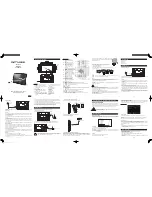
Refer to figure 3 while making linkage adjustments. with engine stopped, check and adjust
linkage as follows:
a.
Before making adjustment, observe and note the hole that the engine stop lever (3) uses to
mount the ball joint (4)
.
It is oval shaped therefore it will allow for a variety of positions for the
ball joint (4) to rest.
b.
Loosen the ball joint nut (7) that fastens the ball joint
(4)
to the stop engine lever. Then
loosen the nut (5) that fastens the ball joint to the threaded rod (2), and remove the ball joint
(4) from the engine stop lever (3)
.
NOTE:
Do not remove the ball joint from the threaded rod.
c.
Be sure that the engine stop lever (3) has not slipped on its shaft. If it has slipped, position it
correctly and tighten securely.
d.
Place both levers (2 and 3) in
NO FUEL
position and hold in place. Attempt to position the
ball joint (4) in the oval hole of the engine stop lever (3), that will allow for a maximum range
of travel of both levers. To do this:
•
Loosen nuts (5) and rotate the ball joint - inward or outward on the threaded rod - as
necessary for making the placement.
•
Hold the removed ball joint in its correct position in the mounting hole of the engine stop
lever (3), and tighten the ball joint nut.
•
Then fasten down the nuts (5) snug in order to inspect linkage travel.
e.
Then manually operate the threaded rod (2) back and forth between no fuel and full speed to
compare its travel with the travel of the engine stop lever (3). If adjustment is unsatisfactory,
try another place in the oval hole in the engine stop lever and readjust the rod length.
f.
When proper adjustment has been completed, tighten the jam nut (5) on the threaded rod (2)
firmly against the ball joint (4).
g.
Check governor linkage for freedom of travel. Move the rod assembly manually to see that
there isn’t any binding or lost motion in linkage. Make corrections if and as required. At
NO
FUEL
position, the engine stop lever should be pulled all the way forward. For maximum
RPM, the actuator shaft should move far enough to force the engine stop lever to use all its
travel as it moves backward.
h.
Start the engine, and set idle speed to 850 RPM +/- 50 RPM. (Refer to Par. 3, (e) (3) for
procedure for setting idle speed). Operate engine at idle speed until it is warmed to operating
temperature.
(2)
Magnetic pickup adjustment
The strength of the magnetic pickup signal to the control box can be weakened if the tip of the
pickup is too far from the flywheel ring gear or if it becomes damaged. If the pickup is removed
for any reason, or if the signal is weak, as indicated by test in Par. 3, e, (3), adjust the pickup as
follows:
a.
Disconnect magnetic pick-up wires at the terminal strip on the governor controller (terminals 3
and 4).
b.
Loosen the jam nut (2, Fig. 4
)
and remove magnetic pickup (1)
.
c.
Inspect to make certain the tip is not damaged from contact with the ring gear teeth. Replace
pickup if it is damaged. If it isn’t, clean the tip of it and re-install it.
The pickup tip must be directly over a tooth and not between teeth when
adjustment is made.
CAUTION
OM-2084 / Operation and Maintenance Manual
90CU24 / Series 500392 Generator Sets
November 27/1997
Chapter 2-3
Page 13
Содержание 90CU24
Страница 193: ......
Страница 194: ......
Страница 195: ......
Страница 196: ......
Страница 197: ......
Страница 198: ......
Страница 199: ......
Страница 200: ......
Страница 201: ......
Страница 202: ......
Страница 203: ......
Страница 204: ......
Страница 205: ......
Страница 206: ......
Страница 207: ......
Страница 208: ......
















































